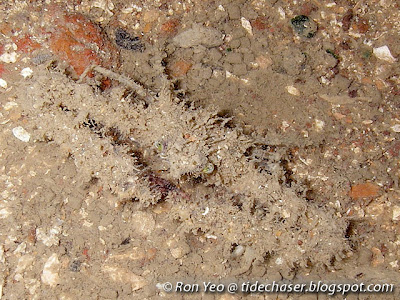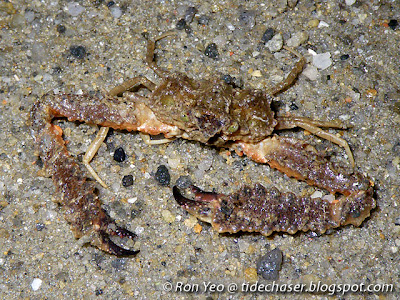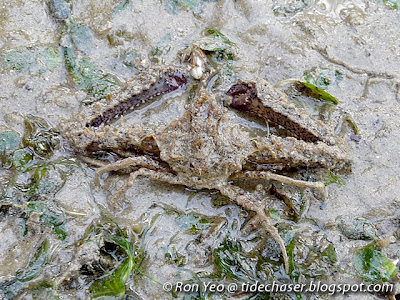Elbow crabs (phylum Arthropoda, subphylum Crustacea, class Malacostraca, order Decapoda, suborder Pleocyemata, infraorder Brachyura, superfamily Parthenopoidea, family Parthenopidae) are typically crabs with long to very long chelipeds (clawed arms) that cannot be hidden completely under the carapace. These long chelipeds gave them their common name, as the joint in the middle resembles an elbow. Despite the chelipeds being so long, the fingers (or pincers) at the tip are usually unable to reach the back of the carapace.

Like other true crabs, elbow crabs have a broad carapace, and a very short and flattened abdomen which is usually folded underneath the body. They also have five pairs of "legs" (including the clawed arms), and hence they are placed in the order Decapoda ("deca" means "ten", while "poda" means "feet"). The gills are leaf-like - a distinctive characteristic of decapods from the suborder Pleocyemata. And as with other crustaceans from the class Malacostraca, their body comprises three main parts - a head with five segments, a thorax with eight segments, and an abdomen with six segments. The head is fused to the thorax, forming a cephalothorax. They have a tough exoskeleton strengthened with calcium carbonate, and the carapace covers the gills but not the abdomen.
They reproduce sexually, and have separate sexes. The females can usually be distinguished from the males by having a broader abdomen. This is an adaptation to allow them to carry the eggs under the abdomen until they hatch.

The surface of an elbow crab's exoskeleton is often uneven with ridges, bumps and spines, and most species have fine hairs on the exoskeleton to trap sediment so that the animal can blend into the surrounding. As a result, they can be hard to spot and identify in the wild.
Studies suggest that they have an omnivorous diet, and possibly hunt for small invertebrates by ambush using their long chelipeds, with aid from their excellent camouflage.
Here are some of the elbow crabs I have photographed in Singapore.

The Common Buckler Crab (Cryptopodia fornicata) got its common name from its domed and somewhat triangular carapace, which resembles a buckler (i.e. a small shield). This nocturnal crab feeds on small invertebrates, and is usually found on in sandy or muddy substrates. It can be distinguished from other elbow crabs by its relatively clean shell (compared to those which trap sediment). They are sometimes confused with box crabs (family Calappidae) due to their somewhat box-like appearance, but they lack the laterally compressed chelipeds found in the latter.

In addition, a look at the underside of the Common Buckler Crab will reveal that the body is rather flattish and looks nothing like a box. The carapace can get to about 7cm across.

The Common Elbow Crab (Rhinolambrus pelagicus) is possible the most commonly seen elbow crab in Singapore, being fairly common in shallow waters. They can sometimes be recognised by the numerous small black rings on the lower parts of the chelipeds together with the intertidal habits, though there are other variations too. The carapace usually does not get wider than 2cm.

The above is an unidentified elbow crab which strongly resembles the previous species, but the lower parts of the chelipeds lack the black rings and are orange in colour. I am not sure if this is a variation or the same species.

Instead of black rings, the lower parts of the chelipeds of this unidentified elbow crab have numoerous black specks. The carapace also appears longer than broad, and there is a sharp angular corner on each side.
References

Like other true crabs, elbow crabs have a broad carapace, and a very short and flattened abdomen which is usually folded underneath the body. They also have five pairs of "legs" (including the clawed arms), and hence they are placed in the order Decapoda ("deca" means "ten", while "poda" means "feet"). The gills are leaf-like - a distinctive characteristic of decapods from the suborder Pleocyemata. And as with other crustaceans from the class Malacostraca, their body comprises three main parts - a head with five segments, a thorax with eight segments, and an abdomen with six segments. The head is fused to the thorax, forming a cephalothorax. They have a tough exoskeleton strengthened with calcium carbonate, and the carapace covers the gills but not the abdomen.
They reproduce sexually, and have separate sexes. The females can usually be distinguished from the males by having a broader abdomen. This is an adaptation to allow them to carry the eggs under the abdomen until they hatch.

The surface of an elbow crab's exoskeleton is often uneven with ridges, bumps and spines, and most species have fine hairs on the exoskeleton to trap sediment so that the animal can blend into the surrounding. As a result, they can be hard to spot and identify in the wild.
Studies suggest that they have an omnivorous diet, and possibly hunt for small invertebrates by ambush using their long chelipeds, with aid from their excellent camouflage.
Here are some of the elbow crabs I have photographed in Singapore.

The Common Buckler Crab (Cryptopodia fornicata) got its common name from its domed and somewhat triangular carapace, which resembles a buckler (i.e. a small shield). This nocturnal crab feeds on small invertebrates, and is usually found on in sandy or muddy substrates. It can be distinguished from other elbow crabs by its relatively clean shell (compared to those which trap sediment). They are sometimes confused with box crabs (family Calappidae) due to their somewhat box-like appearance, but they lack the laterally compressed chelipeds found in the latter.

In addition, a look at the underside of the Common Buckler Crab will reveal that the body is rather flattish and looks nothing like a box. The carapace can get to about 7cm across.

The Common Elbow Crab (Rhinolambrus pelagicus) is possible the most commonly seen elbow crab in Singapore, being fairly common in shallow waters. They can sometimes be recognised by the numerous small black rings on the lower parts of the chelipeds together with the intertidal habits, though there are other variations too. The carapace usually does not get wider than 2cm.

The above is an unidentified elbow crab which strongly resembles the previous species, but the lower parts of the chelipeds lack the black rings and are orange in colour. I am not sure if this is a variation or the same species.

Instead of black rings, the lower parts of the chelipeds of this unidentified elbow crab have numoerous black specks. The carapace also appears longer than broad, and there is a sharp angular corner on each side.
References
- De Grave, S., N. D. Pentcheff , S. T. Ahyong, T.-Y. Chan, K. A. Crandall, P. C. Dworschak, D. L. Felder, R. M. Feldmann, C. H. J. M. Fransen, L. Y. D. Goulding, R. Lemaitre, M. E. Y. Low, J. W. Martin, P. K. L. Ng, C. E. Schweitzer, S. H. Tan, D. Tshudy & R. Wetzer. 2009. A classification of living and fossil genera of decapod crustaceans. The Raffles Bulletin of Zoology, supplement 21, pp. 1-109.
- Debelius, H. 1999. Crustacea - Guide of the world. IKAN, Frankfurt. 321pp.
- ETI BioInformatics. 2012. Marine species identification portal. Retrieved Jul 8, 2013, from http://species-identification.org.
- Ng, P. K. L., S. S. L. Lim, L. K. Wang & L. W. H. Tan. 2007. Private lives: An exposé of Singapore's shores. The Raffles Museum of Biodiversity Research, Department of Biological Sciences, National University of Singapore. 212 pp.
- Ng, P. K .L., R. T. Corlett & H.T.W. Tan (eds.). 2011. Singapore biodiversity: An encyclopedia of the natural environment and sustainable development. Singapore: Editions Didier Millet. 552 pp.
- Tan, S. H. 2004. A Systematic Revision of the Parthenopidae(Crustacea: Decapoda: Brachyura). Unpublished PhD Thesis, National University of Singapore. 729 pp.
- World Register of Marine Species. 2012. Retrieved Jun 10, 2013, from http://www.marinespecies.org.

No comments:
Post a Comment